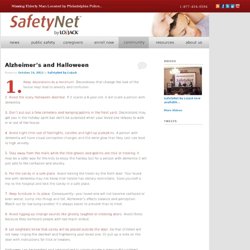

Safety-Net. Today’s is World Alzheimer’s Day, a day on which Alzheimer’s organizations around the world concentrate their efforts on raising awareness about Alzheimer’s disease and dementia.

Every 68 seconds, someone develops Alzheimer’s disease. At current rates, experts believe the number of Americans living with Alzheimer’s will quadruple to as many as 16 million by the year 2050. One of the major concerns associated with Alzheimer’s is the fact that up to 60 percent of all patients with the disease will wander (source: Alzheimer’s Association). Just this Wednesday, a 78-year-old Braintree man who is diagnosed with Alzheimer’s wandered from his home. Fortunately, he was located more than a mile away in front of a residential home. At SafetyNet, we recommend that caregivers consider doing any or all of the following to best protect their loved ones suffering from Alzheimer’s: Fill out a 9-1-1 disability indicator form and submit it to your local law enforcement agency. Share This: The Ultimate GPS Child Tracking Buyer's Guide (GPSmagazine.com)
Table of Contents First, a quick primer on the different technologies involved: A-GPS, or Assisted GPS leverages both cellular and GPS technology.
A-GPS devices determine their position using traditional GPS technology, but upload this information back to you via cellular technology. A-GPS devices are essentially GPS-enabled cellular devices, and therefore require a monthly service charge for the data. Monthly service fees range from around $20 - $50 per month, depending on the usage plan you choose. RF tracking devices don't use GPS at all, and instead rely on Radio Frequencies to determine positioning information. GPS and RF devices serve slightly different functions; GPS is great for pinpointing your child's general position on the map, but it does little to help you find a child who's wandered off at the mall. 1. Verdict: Not Recommended Figure 1: Loc8tor Plus Loc8tor's homing tags are very small and lightweight, and the batteries can last for months. 2. 3.
IonKids Child Locator Device Review. The age of your child should determine the type of child locator device is best for you along with the types of places you frequent with the family. Let’s go through one circumstance: you turn away for 5 seconds and then turn back, your 4 year old child is gone. Using the Ion Kids locator and alert device can locate your child by a watch they wear for up to 350 feet away. Even better yet you can set a safety zone, if your child goes outside the preset distance of the safety zone the alarm goes off. Usually you can immediately look up and scan the area for their recovery.
If they are not in sight for some reason, just pull out your Ionkids locator unit, hit the “find” button for the exact location of your child. The Brickhouse child locator device as advertised in the Duracell commercial works in much the same way with a range of up to 600 feet. I recommend either unit for children under 12 and both are priced at about $ 170 to $ 180. Spark Nano GPS Car Tracking Device.